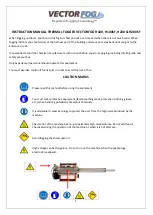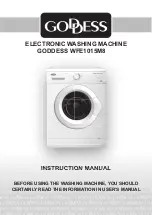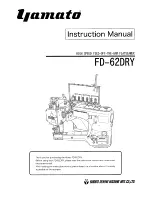
7
3.3 Throat plate, feed dog
3.3.1 Description
The throat plate (1) is universal for all categories of sewing.
Four feed-dog types, differing from each other by the width
of the needle hole andby the teeth size as required by the
respective sewing category, are available (see tab. in the par.
11.2).
3.3.2 Mounting and removing the throat plate
When mounting the throat plate (1), the finger (4) of the bobbin
case must fit into the recess (5) of the throat plate.
Caution! Danger of injury!
Switch off the main switch! Before starting the
setting operation, wait until the motor stops!
- Turn the finger (4) in the sense towards the throat plate (1).
-
Place the throat plate (1) into the bed plate.
- Screw in the screws (7).
- When removing the insert, proceed in an inverse sequence.
3.4 Thread tensioners and limiter
3.4.1 Description
The main tensioners (1) serves for creating the tension of the
thread when tightening the stitch. The auxiliary tensioner (2)
reduces the risk of pulling out of the thread after the thread
trimming when removing the sewn material, when the thread
is passed through this material and when the main tensioner
is relieved.
The main tensioner is relieved by the mechanism
controlled by the shaft of the presser bar lifting (3) holding
the lever (4) with a pulley. The motion is then transmitted by
the lever (5) and the tie rod (6) on the thread tensioner plate
(7) whose displacement (motion) relieves the thread tensioner
springs (8). In machines provided with a thread trimming
device, the main tensioners (1) are relieved as well upon the
switching on of the electromagnet (10) whose electromagnetic
field will attract the thread tensioner plate (7).
The mechanism
of the adapting spring (12) maintains the upper thread in its
tensioned state when passing through the hook
and when
entering the needle into the sewn material
. The thread limiter
(13) limits the length of the thread fed by the take-up lever
when moving from the upper to the bottom dead centre to get
a controlled passing of the thread through the hook.
The
auxiliary guide (14) maintains the upper thread in front of the
needle in a tensioned condition and helps against pulling the
thread from the needle after thread trimming.
3.4.2 Setting the tension of the main and auxiliary
tensioners
The tension of the main thread tensioners is regulated by
means of the nuts (1).
The force of tensioning the thread is
measured by the dynamometer (2) as it is shown on the
illustration.
The size of this force differs according to the
category, and its orientation value is indicated in the par. 11.2.
The tension of the auxiliary tensioner is regulated using the
nut (3). It should be the least possible, but sufficient for
unthreading the thread from the sewn material when removing
the sewn material from the pressing element without leaving
the tensioner.
7
1
4
5
3
4
5
6
10
A
7
2
1
13
12
14
8
2
3
1
www.promelectroavtomat.ru











































